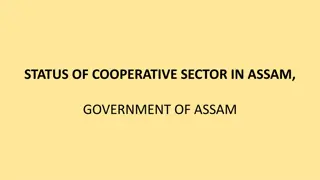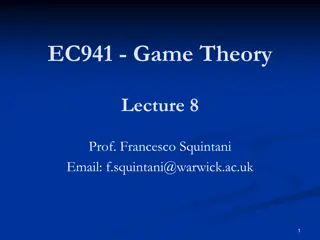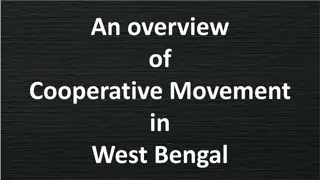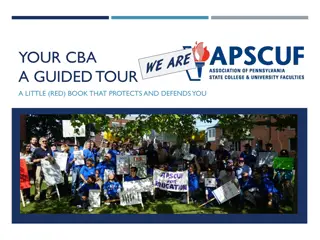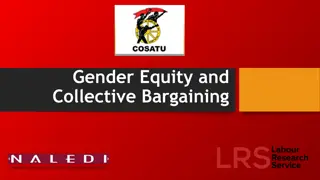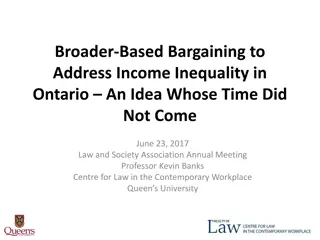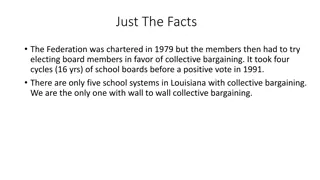Overview of Cooperative Game Theory and Bargaining Solutions
Cooperative game theory explores situations where players have mutual benefits in cooperating. The focus is on bargaining solutions to reach agreements despite conflicting interests. Key concepts include Nash Bargaining Solution, Kalai-Smorodinsky Bargaining Solution, and Rubinstein Bargaining Process. Players in cooperative games strive for efficient and fair agreements through negotiation strategies. Cooperative game theory complements non-cooperative game theory in addressing issues like distribution of gains and enforcement of agreements.
Download Presentation

Please find below an Image/Link to download the presentation.
The content on the website is provided AS IS for your information and personal use only. It may not be sold, licensed, or shared on other websites without obtaining consent from the author. Download presentation by click this link. If you encounter any issues during the download, it is possible that the publisher has removed the file from their server.
E N D
Presentation Transcript
Lecture 12: Cooperative Game Theory Nash Bargaining Solution Yi, Yung ( ) KAIST, Electrical Engineering http://lanada.kaist.ac.kr yiyung@kaist.edu
Where We Are? Non-cooperative game theory Various games Normal-form game Extensive-form game Repeated game Bayesian game Cooperative game theory Bargaining (today) Coalitional game
Introduction Introduction to cooperative game Bargaining solution Nash Bargaining Solution Kalai Smorodinsky Bargaining Solution Rubinstein Bargaining Process Examples Coalitional game
Cooperative Game Theory Underlying situation Players have mutual benefit to cooperate Two categories Bargaining problems Coalitional game
Introduction to Bargaining Bargaining situation A number of individuals have a common interest to cooperate (e.g., trade or sharing of resource), but a conflicting interest on how to cooperate (terms of agreement, ) Key tradeoff Players wish to reach an agreement rather than disagree. But, each player is self-interested
Introduction to Bargaining What is bargaining? Process through which the players on their own attempt to reach an agreement Can be tedious, involving offers and counter- offers, negotiations, etc. Bargaining theory studies these situations, their outcome, and the bargaining process
Examples Painting Seller: values at 1000$ Buyer: values at 1500$ What s the final price? Sharing Resource Shared resource among nodes How to share? Every node wants to get larger portion of resource
Introduction Key issues in bargaining 1. The players must inspect efficiency and the effect of delay and disagreement on it, i.e., jointly efficient They seek a jointly efficient mutual agreement 2. Distribution of the gains from the agreement Which point from the efficient set must the players select? 3. What are the joint strategies that the players must choose to get the desired outcome? 4. How to finally enforce the agreement? Link to game theory Issues 1 and 2 are tackled traditionally by cooperative game theory Issues 3 and 4 are strongly linked to non-cooperative game theory
Motivating Example (1) I can give you 100$ if and only if you agree on how to share it Can be deemed unsatistifactory Given each Man s wealth!!! Rich Man (Wealth = $1010) Poor Man (Wealth = $10)
Motivating Example (2) I can give you 100$ if and only if you agree on how to share it Can be deemed unsatistifactory Given each Man s wealth!!! Rich Man (Wealth = $1010) Poor Man (Wealth = $10)
The Nash Bargaining Solution John Nash s approach When presented with a bargaining problem such as the rich man poor man case, how can we pick a reasonable outcome? Interested in the outcome rather than the process The Nash Bargaining Solution was proposed in 1950 using an axiomatic approach and is considered as one of the key foundations of bargaining problems
Setup Consider two players for simplicity (i=1,2) Outcome space D: the outcome of disagreement Utility function on Utility of disagreement ? = (?1,?2), where ??= ??? A Nash bargaining problem is defined by the pair (S,d)
The Nash Bargaining Solution Can we find a bargaining solution, i.e., a function f that specifies a unique outcome f(S,d) S ? Axiomatic approach proposed by Nash Axiom 1: Feasibility Axiom 2: Pareto efficiency Axiom 3: Symmetry Axiom 4: Invariance to linear transformation Axiom 5: Independence of irrelevant alternatives
The Nash Bargaining Solution Axiom 1: Feasibility Feasibility implies that The outcome of the bargaining process, denoted (u*,v*) cannot be worse than the disagreement point d = (d1,d2), i.e., (u*,v*) (d1,d2) Strict inequality is sometimes defined Trivial requirement but important: the disagreement point is a benchmark and its selection is very important in a problem!
The Nash Bargaining Solution Axiom 2: Pareto efficiency Players need to do as well as they can without hurting one another At the bargaining outcome, no player can improve without decreasing the other player s utility Pareto boundary of the utility region Formally, no point (u,v) S exists such that u > u*and v v* or u u*and v > v*
The Nash Bargaining Solution Axiom 3: Symmetry If the utility region is symmetric around a line with slope 45 degrees then the outcome will lie on the line of symmetry Formally, if d1= d2 and S is symmetric around u = v, then u*= v* Axiom 4: Invariance to linear transformation The bargaining outcome varies linearly if the utilities are scaled using an affine transformation
The Nash Bargaining Solution Axiom 5: Independence of irrelevant alternatives If the solution of the bargaining problem lies in a subset U of S, then the outcome does not vary if bargaining is performed on U instead of S If the solution of a larger set is a member of a smaller set, then this solution is also the solution of the smaller set
The Nash Bargaining Solution Theorem. Nash showed that there exists a unique solution f satisfying the axioms, and it takes the following form: Known as the Nash product When d1= d2= 0, this is equivalent to the famous solution of telecommunication networks: Proportional fairness
Rich man poor man problem revisited Considering logarithmic utilities and considering that what the men s current wealth is as the disagreement point The Nash solution dictates that the rich man receives a larger share of the 100$ Is it fair? Fairness is subjective here, the rich man has more bargaining power so he can threaten more to stop the deal The poor man also values little money big as he is already poor! Variant of the problem considers the 100$ as a debt, and, in that case, the NBS becomes fair, the richer you are the more you pay!
The Nash Bargaining Solution The NBS is easily extended to the N-person case The utility space becomes N-dimensional and the disagreement point as well Computational complexity definitely increases and coordination on a larger scale is required Solution to the following maximization problem
The Nash Bargaining Solution If we drop the Symmetry axiom we define the Generalize Nash Bargaining Solution Solution to the following maximization problem Value between 0 and 1 representing the bargaining power of player i If equal bargaining powers are used, this is equivalent to the NBS
Nash Bargaining Solution Summary The NBS/GNBS are a very interesting concept for allocating utilities in a bargaining problem Provide Pareto optimality Account for the bargaining power of the players but.. Can be unfair, e.g., the rich man poor man problem Require convexity of the utility region Independence of irrelevant alternatives axiom Provide only a static solution for the problem, i.e., no discussion of the bargaining process Alternatives? The Kalai Smorodinsky solution Dynamic bargaining and the Rubinstein process
Dynamic Bargaining The NBS is the static solution in the sense that we only care about the outcome How about the bargaining process? Dynamic bargaining Interested in the players interactions to reach an agreement Broader than static bargaining, although linked to it In this trial lecture, we cover the Rubinstein process although many others exists Famous one: Rubinstein Bargaining Process There are other bargaining processes (a hot research topic in game theory)












